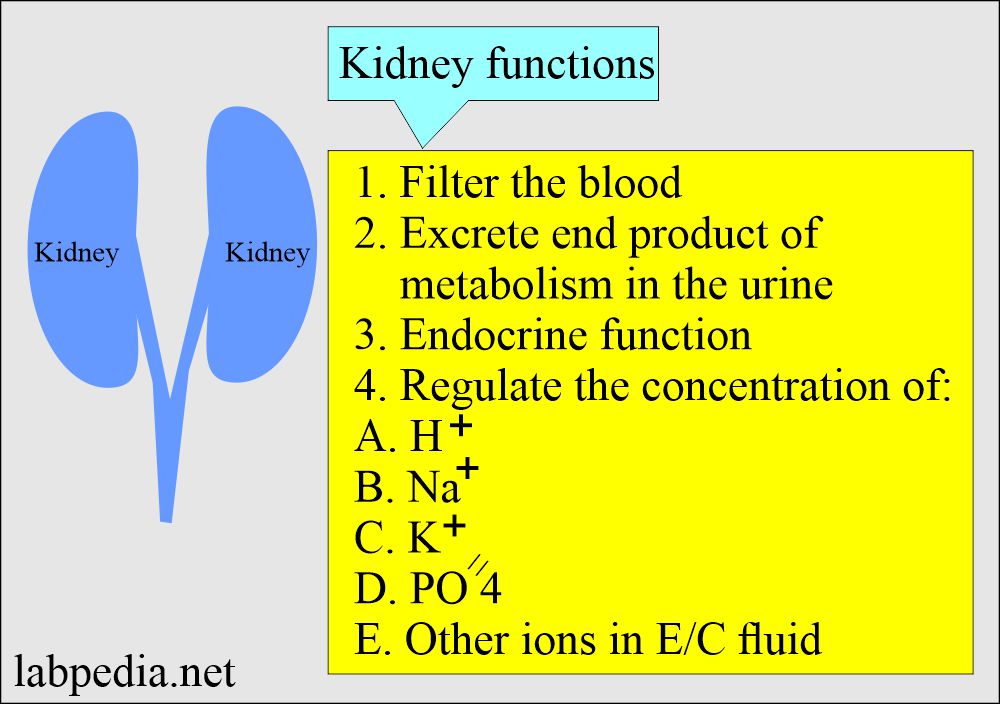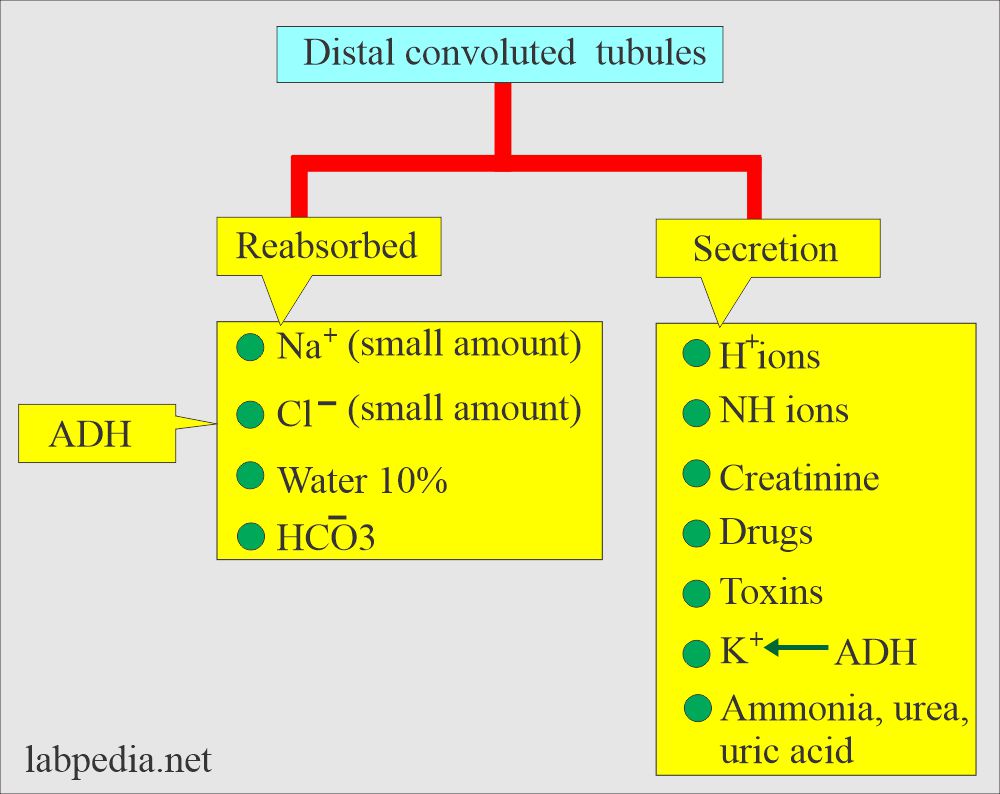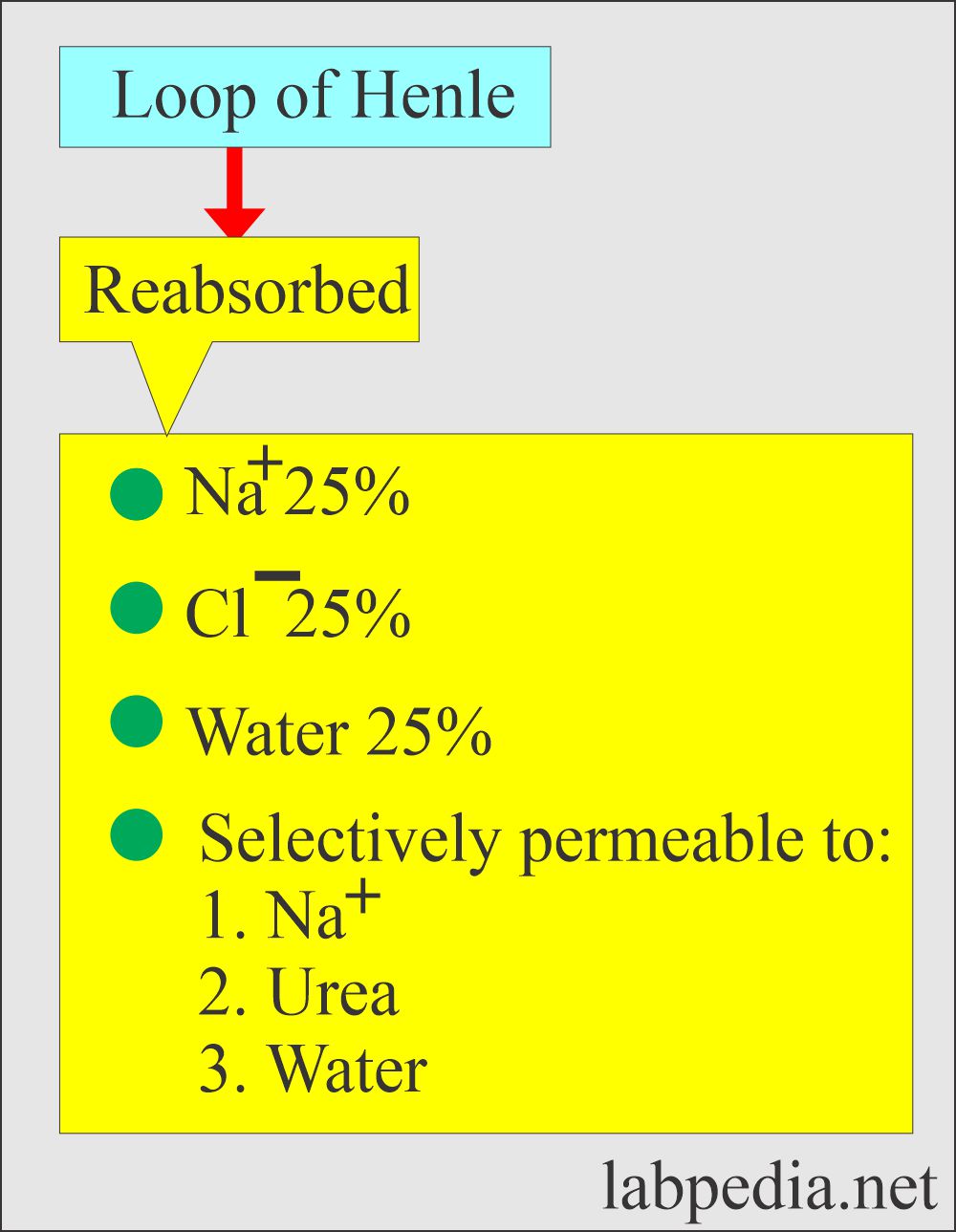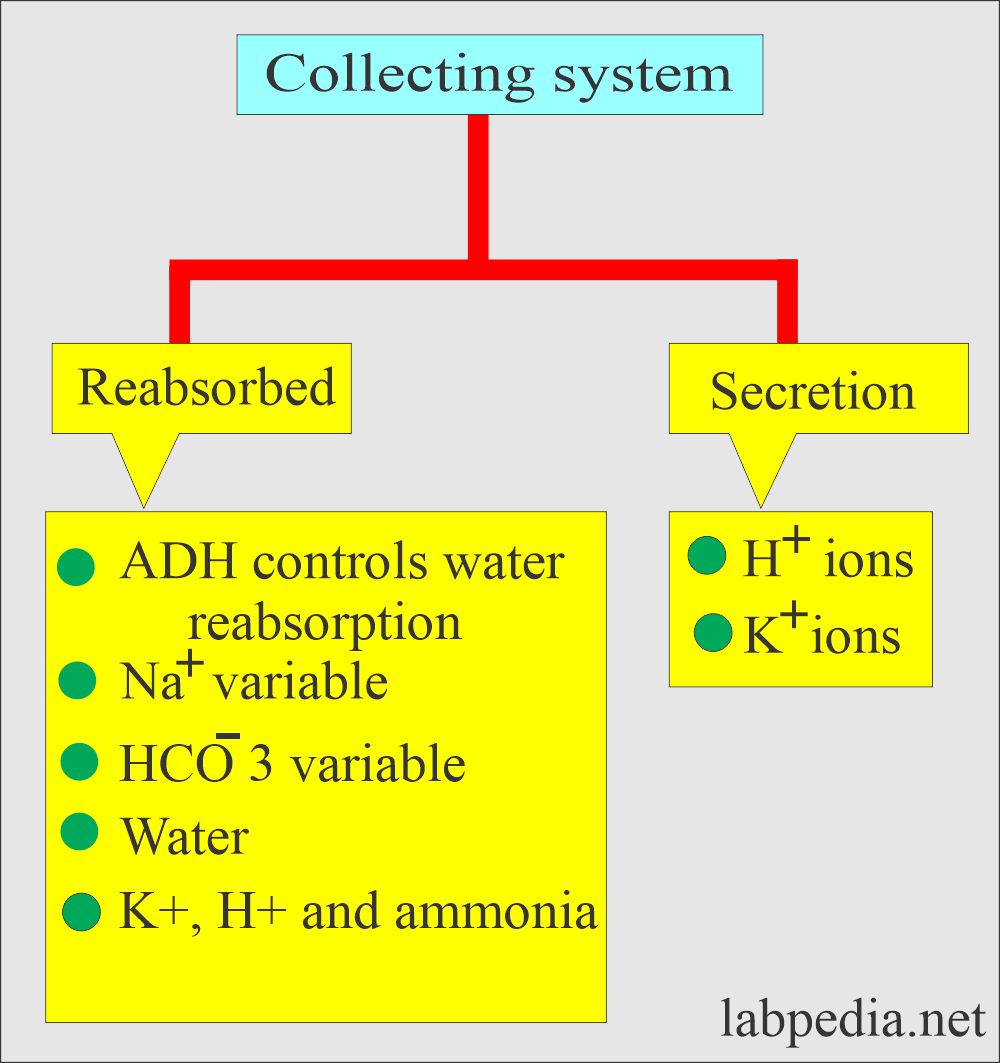Renal Functions:- Part 1 – Renal Functions Tests
Renal Functions Tests
What sample is needed for Renal Function Tests?
- These tests are done on the patient’s serum or plasma.
- A urine sample may also be needed.
- The specimen is stable for several days at 4 to 6 °C and, when frozen, for at least 2 to 3 months.
- The creatinine sample is stable when refrigerated for 24 hours.
What are the precautions for Renal Function Tests?
- Avoid a high concentration of Na fluoride as this inhibits urease.
- Discontinue Vitamin B12 supplements at least 72 hours before sampling.
What are the Indications for Renal Function Tests?
- These tests diagnose any renal disease.
- These tests can tell the prognosis of the patient.
- It can assess the remaining functional capacity of the kidneys.
How will you describe the pathophysiology of Renal Functions?
- Kidneys play an important role in the homeostatic system of the body.
- The kidney is the highly specialized organ in the body for:
- Elimination of the waste products of metabolism.
- It preserves the internal environment of the cells, maintaining the pH, water balance, ionic equilibrium, and fluid osmotic pressure.
- The impairment of renal function correlates with morbidity and mortality.
What is the Nephron structure?
- This is the functional unit of the kidney.
- Each kidney contains 400,000 to 800,000 nephrons.
- Each nephron consists of the following:
- Glomerulus.
- Proximal Tubule.
- The loop of Henle.
- Distal Tubule.
- Collecting ducts.
- Kidneys’ biological functions are:
- Excretion.
- Homeostatic regulation.
- Endocrine function.
- Urine formation.
What is the role of The proximal tubules?
These are most metabolically active and lead to the reabsorption of :
- 60% to 90% of the glomerular filtrate.
- 70% of the Na+ and Cl–.
- Other substances are potassium, glucose, bicarbonate, phosphate, and sulfate.
- 90% of H+ is excreted.
What is the role of Distal tubules?
- These are involved in the excretion and secretion of :
- ADH and aldosterone help in reabsorption.
- K+ is secreted in response to aldosterone.
- Sodium, Potassium.
- Chloride and hydrogen.
- H+, ammonia, urea, and uric acid were secreted, and bicarbonate was reabsorbed.
What is the role of Loop of Henle?
- Selectively permeable to sodium, urea, and water.
- The descending loop is highly permeable to water but not salt.
- Urine becomes concentrated.
- The ascending loop is impermeable to water but actively reabsorbs salts, decreasing the concentration of the urine.
What is the role of the collecting system?
- This is under the control of ADH.
- Aldosterone regulates NaCl reabsorption.
- K+, H+, and ammonia are reabsorbed.
- Urine formed is carried to the ureter and the urinary bladder.
What is the excretory function of kidneys?
- This helps the body to get rid of the following:
- The end product of metabolism.
- Excess of inorganic substances digested in the diet.
- There is the removal of the waste products of metabolism like urea, creatinine, uric acid, and amino acids.
- Remove the inorganic substances ingested in the diet, such as sodium, potassium, chloride, calcium, phosphate, magnesium, bicarbonate, and sulfate.
- The kidney also removes foreign heavy metals, drugs, and antibiotics.
What is the regulatory function of kidneys?
- This is a complex system of control in which intrarenal and extrarenal humoral factors are involved.
- Electrolyte homeostasis takes place predominantly in the proximal collecting tubules.
- Where roughly 70% of ultrafiltrate’s sodium, chloride, and water is reabsorbed.
- Other solutes are bicarbonate, phosphate, calcium, and potassium.
What is the role of kidneys in water homeostasis?
- Water is reabsorbed in:
- Roughly 70% in the proximal tubule.
- 5% in the loop of Henle.
- 10% in the distal tubule.
- Rest in the collecting ducts.
What is the endocrine Function of the kidneys?
- The kidney synthesizes hormones and is the target organ for other site-formed hormones.
- The kidney is the site of degradation of hormone-like insulin and aldosterone.
- The kidney produces hormones like:
- Erythropoietin stimulates RBC production.
- Renin.
- Prostaglandins.
- Thromboxane.
- Vit. D. It converts 25-hydroxyvitamin D3 to form the biologically active vitamin D.
How will you define the Glomerular filtration rate (GFR)?
- This is the quantity of blood cleared of substances like creatinine and urea per unit of time.
- Substances like creatinine and urea filter through the kidney glomeruli at the rate of milliliters (mL) per minute.
- GFR depends upon the following:
- Plasma concentration of the substance.
- The excretion rate of the kidney will reflect the following:
- Renal plasma flow.
- Glomerular filtration rate.
- This substance should not be reabsorbed, secreted, synthesized, or degraded in the nephron.
- GFR is the most reliable measure of kidney function.
- GFR may be measured by obtaining clearance for exogenous substances like inulin.
- Endogenous substances like creatinine and urea nitrogen may measure GFR.
What are the characteristic features of Urine?
- This is a fluid excreted by the kidneys.
- It is stored in the urinary bladder and discharged through the urethra.
- Normal urine is sterile, clear, and amber in color.
- It is slightly acidic and has a characteristic odor.
- Urine contains dissolved compounds, cells, and crystals.
- In a healthy person, urine is clear, has a pH of 5 to 6, and has an average specific gravity of 1.024.
- The normal urine output per day is 500 mL.
- Urinary output is described as :
- Anuria < 100 ml/day.
- Oliguria < 400 ml/day.
- Polyuria > 2 L/day.
What are the Routine Renal Function tests?
- BUN or blood urea.
- Creatinine.
- Calcium.
- Magnesium.
- Phosphorus.
- Albumin.
- Total protein.
- Electrolytes (Sodium and Potassium).
- Chloride in urine and blood.
- Creatinine clearance.
- Creatinine, 24- hours urine.
- Protein in the urine (24-hour urine sample is needed).
- Microalbuminuria.
- Urine analysis.
- GFR.
What are the normal renal function tests?
Source 1
Urea nitrogen (Urea N) Concentration:
| Age | mg/dL |
| Cord | 21 to 40 |
| Premature (One week) | 3 to 25 |
| <1 year | 4 to 19 |
| Infants/child | 5 to 18 |
| 18 to 60 years | 6 to 20 |
| 60 to 90 years | 8 to 23 |
| >90 years | 10 to 31 |
Creatinine Concentration:
| Age | mg/dL |
| Cord blood | 0.6 to 1.2 |
| Newborn 1 to 4 days | 0.3 to 1.0 |
| Infants | 0.2 to 0.4 |
| Child | 0.3 to 0.7 |
| Adolescent | 0.5 to 1.0 |
| 18 to 60 years | |
| Male | 0.9 to 1.3 |
| Female | 0.6 to 1.1 |
| 60 to 90 years | |
| Male | 0.8 to 1.3 |
| Female | 0.6 to 1.2 |
| >90 years | |
| Male | 1.0 to 1.7 |
| Female | 0.6 to 1.3 |
Other sources
- Urea
- 5 to 39 mg/dL.
- BUN
- 7 to 18 mg/dL.
- Creatinine
- Male = 0.9 to 1.5 mg/dL.
Female = 0.7 to 1.3 mg/dL.
What are the normal renal function tests?
| Renal parameter | Normal range |
|
|
|
|
|
|
How will you classify the severity of renal failure?
| The degree of renal failure | GFR mL/min | Creatinine mg/dL | Clinical presentation |
|---|---|---|---|
|
30 to 50 | 1.9 | Hypertension |
|
10 to 30 | 4.0 | Anemia |
|
< 10 | 8.0 | Anemia |
|
< 5 | 16.9 | acidosis, hyperkalemia, coma, and death |
- Note: These tests are described in detail under their names. Please see part 2 of the renal function test.
Questions and answers:
Question 1: What are the biological functions of the kidney?
Question 2: What is anuria?








Write
Please elaborate on your comment. But still thanks.
Very nice blog…..i am a final year student from kolkata,india….
Sir, i appreciate your hardwork…..your blog is very short , crisp, to the point
Thanks for the comments. I am updating the various topics. I will try to make the Renal function parameter better.
Presentation is very succinct and informative and is helping me understand and study tremendously. thank you for putting this out there.
Thanks for the comments.
Thanks very much
For sacrifice devoted and dedicated your valuable time
Thanks a lot.
Very nice bosss….. Your Article very easy and shorts thank you so muchhh
Thanks a lot for the encouraging remarks.
This is a very good source for medical students to come and take a quick look at a topic. With concise and easy to understand format
Thanks a lot.
thanks alot
Welcome.
Great work.
Thanks.